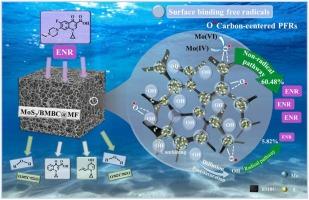Three-dimensionally structured MoS2@biochar breaks through the bottleneck in antibiotic wastewater treatment: Greater efficiency and self-motivated oxidation pathway
IF 11.3
1区 环境科学与生态学
Q1 ENGINEERING, ENVIRONMENTAL
引用次数: 0
Abstract
Two-dimensional (2D) MoS2 has been widely used to remove antibiotics. However, low selectivity for antibiotic pollutants, dependence on applied energy and oxidant, and secondary contamination are still the bottlenecks of this system for treating antibiotic wastewater. In this study, we proposed a three-dimensional (3D) material (3MoS2/BMBC@MF) based on MoS2 and biochar with melamine sponge as the backbone. Compared with the 2D material (MoS2/BMBC), 3MoS2/BMBC@MF performed significantly better in enrofloxacin (ENR) removal, with an increase in the removal degree from 60.8 % to 88.1 %, and acted mainly through the degradation pathway rather than relying solely on the adsorption effect. It was shown that the direct oxidation process (DOP) behind the 3D materials is the key to the self-activated oxidation pathway. The three-dimensional structure enhances the generation and transfer pathways of persistent free radicals (PFRs) and electrons, realizing a multi-dimensional activation mechanism through its unique three-dimensional network, which greatly improves the redox capacity of the material. Upon exposure to pollutants, 3MoS2/BMBC@MF generates carbon-centered radicals of PFRs, which degrade ENR through mediated electron transfer. Coupled with the three-dimensional structure that contributes to the homogeneous dispersion of the active substances, dense steric active centers are formed in the grid skeleton by redox cycling of Mo ions to degrade antibiotics via DOP. Meanwhile, 3MoS2/BMBC@MF possesses good recyclability and maintains high efficiency in recycling. The structural design of this material not only enhances the removal efficiency and reduces the environmental impact, but also provides new potentials and solutions for practical water treatment of antibiotic contaminants.

三维结构MoS2@biochar突破抗生素废水处理瓶颈:更高效率和自激氧化途径
二维(2D)二硫化钼已广泛应用于抗生素的去除。然而,对抗生素污染物的选择性低、对外加能量和氧化剂的依赖以及二次污染仍然是该系统处理抗生素废水的瓶颈。在本研究中,我们以三聚氰胺海绵为骨架,提出了基于二硫化钼和生物炭的三维(3D)材料(3MoS2/BMBC@MF)。与二维材料(MoS2/BMBC)相比,3MoS2/BMBC@MF对恩诺沙星(ENR)的去除效果明显更好,去除率从60.8%提高到88.1%,并且主要通过降解途径而不是单纯依靠吸附作用。结果表明,3D材料背后的直接氧化过程(DOP)是自激活氧化途径的关键。三维结构增强了持久性自由基(PFRs)和电子的生成和转移途径,通过其独特的三维网络实现了多维活化机制,大大提高了材料的氧化还原能力。暴露于污染物后,3MoS2/BMBC@MF产生PFRs的碳中心自由基,通过介导的电子转移降解ENR。再加上三维结构有利于活性物质均匀分散,Mo离子通过DOP氧化还原循环降解抗生素,在网格骨架中形成密集的立体活性中心。同时,3MoS2/BMBC@MF具有良好的可回收性,并保持较高的回收效率。该材料的结构设计不仅提高了去除效率,减少了对环境的影响,而且为实际水处理抗生素污染物提供了新的潜力和解决方案。
本文章由计算机程序翻译,如有差异,请以英文原文为准。
求助全文
约1分钟内获得全文
求助全文
来源期刊

Journal of Hazardous Materials
工程技术-工程:环境
CiteScore
25.40
自引率
5.90%
发文量
3059
审稿时长
58 days
期刊介绍:
The Journal of Hazardous Materials serves as a global platform for promoting cutting-edge research in the field of Environmental Science and Engineering. Our publication features a wide range of articles, including full-length research papers, review articles, and perspectives, with the aim of enhancing our understanding of the dangers and risks associated with various materials concerning public health and the environment. It is important to note that the term "environmental contaminants" refers specifically to substances that pose hazardous effects through contamination, while excluding those that do not have such impacts on the environment or human health. Moreover, we emphasize the distinction between wastes and hazardous materials in order to provide further clarity on the scope of the journal. We have a keen interest in exploring specific compounds and microbial agents that have adverse effects on the environment.
 求助内容:
求助内容: 应助结果提醒方式:
应助结果提醒方式:


